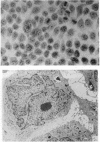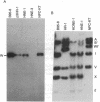Abstract
Two epithelial tumor cell lines were established from biopsy specimens of nasopharyngeal carcinomas (NPC). The specimens were taken from poorly differentiated squamous cell carcinomas of the nasopharynx. The tissues were prepared for cell culture and eventually two continuous epithelial cell lines were obtained and designated HONE-1 and HNE-1. Light and electron microscopic examination of these two cell lines demonstrated cells with an epithelial morphology including the presence of desmosomes. The HNE-1 cell line has been passaged more than 100 times and the HONE-1 cell line has been passaged more than 90 times. It was found that early-passage uncloned HNE-1 cells (passage 23) could be superinfected with the B95-8 and NPC-EBV isolates as demonstrated by the induction of Epstein-Barr virus (EBV)-specific early antigen(s) in a small percentage of the cells; HONE-1 cells could also be superinfected with EBV. Southern blot analysis detected EBV DNA in samples from uncloned HNE-1 cells at passages 12, 17, 21, 27, and 35. However, by passage 45, EBV DNA could no longer be detected in HNE-1 cells by Southern blot analysis. The EBV genome was detected in parental HONE-1 cells at subculture 9 and in clone 40 cells up to passage 40 thus far. When HNE-1 cells were examined for the expression of the EBV-encoded nuclear antigen (EBNA) at passage 12, only about 10% of the cells were found to be positive. The percentage of EBNA-positive HNE-1 cells decreased as the cells were passaged. A similar loss of EBNA was observed in uncloned HONE-1 cells, but not in HONE-1 clone 40 cells. In clone 40, which has been passaged 40 times thus far, 85-90% of the cells are still EBNA-positive. The data suggest that EBV genome-positive HNE-1 and HONE-1 cells were lost as the cells were cultivated in vitro and that cloning the cells at an early passage level may be critical in maintaining EBV genome-positive epithelial NPC cells. These EBV genome-positive epithelial NPC cell lines will be useful for studying the association of EBV and NPC.
Full text
PDF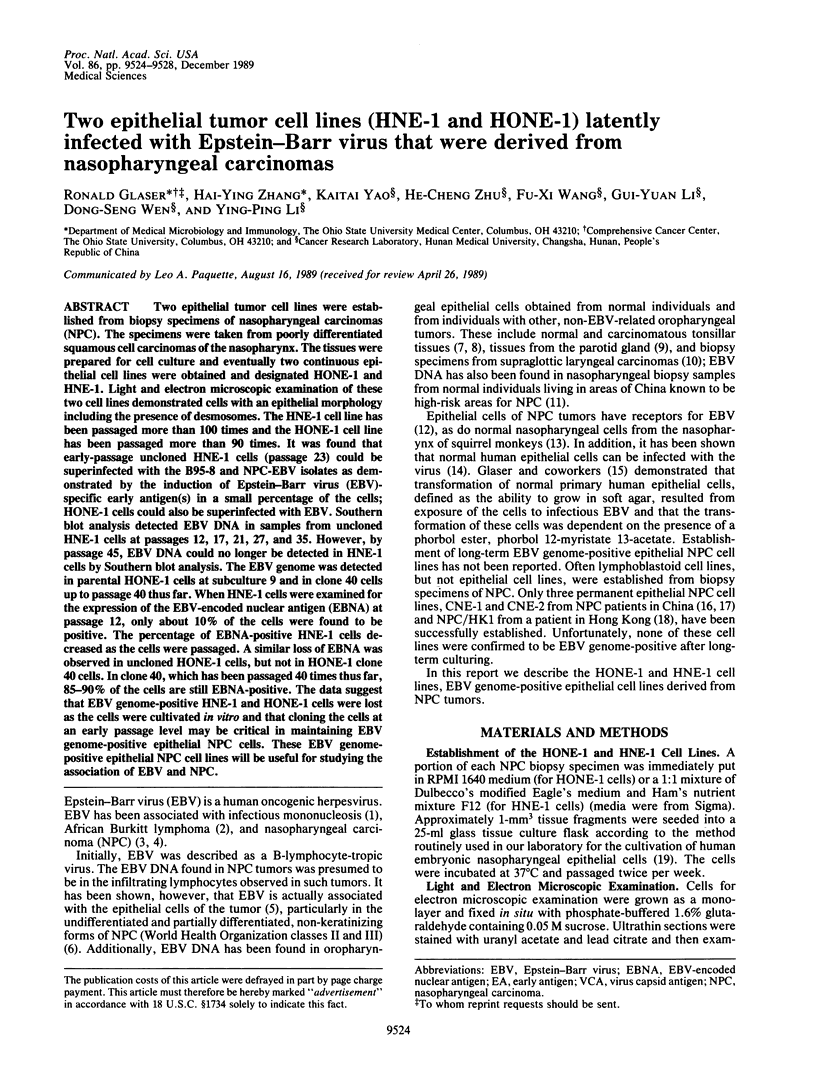
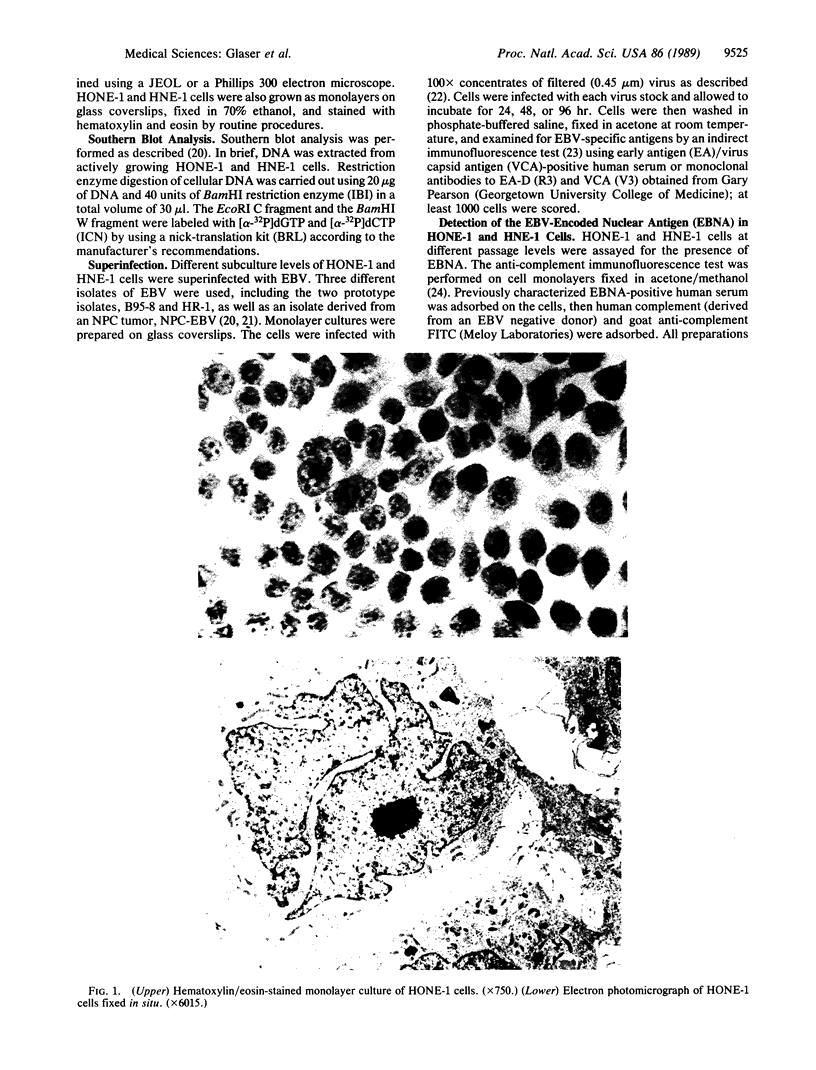
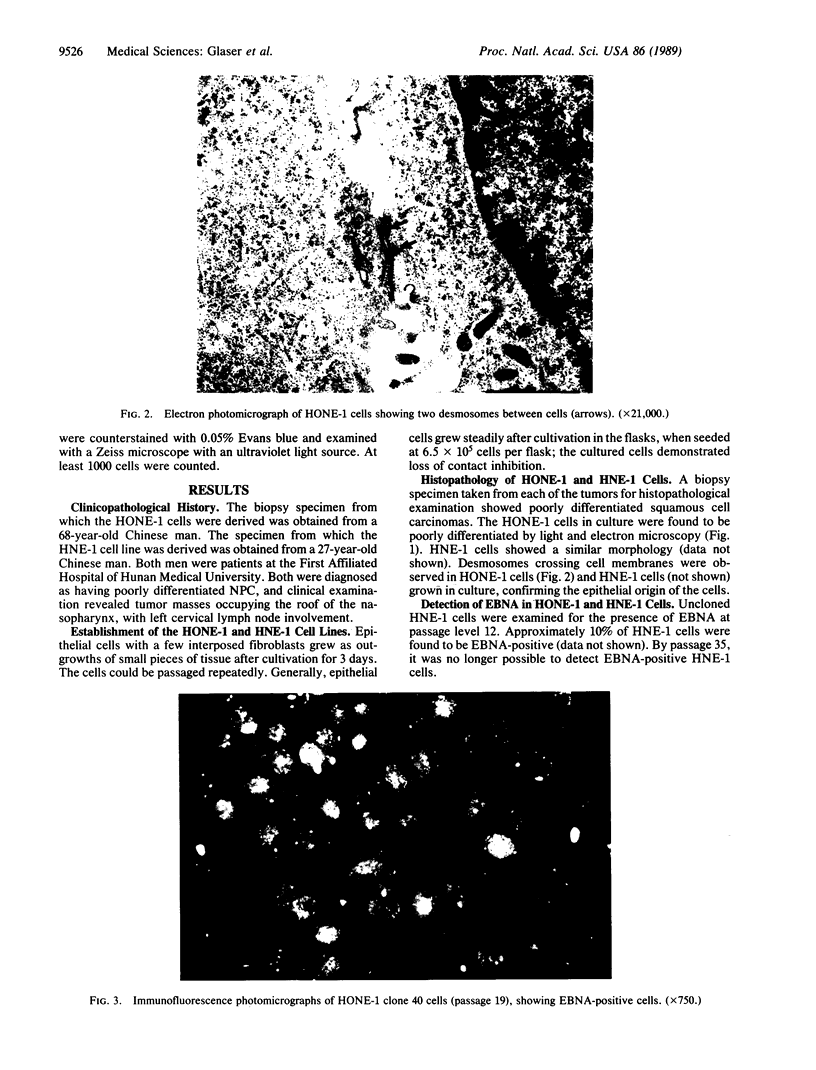
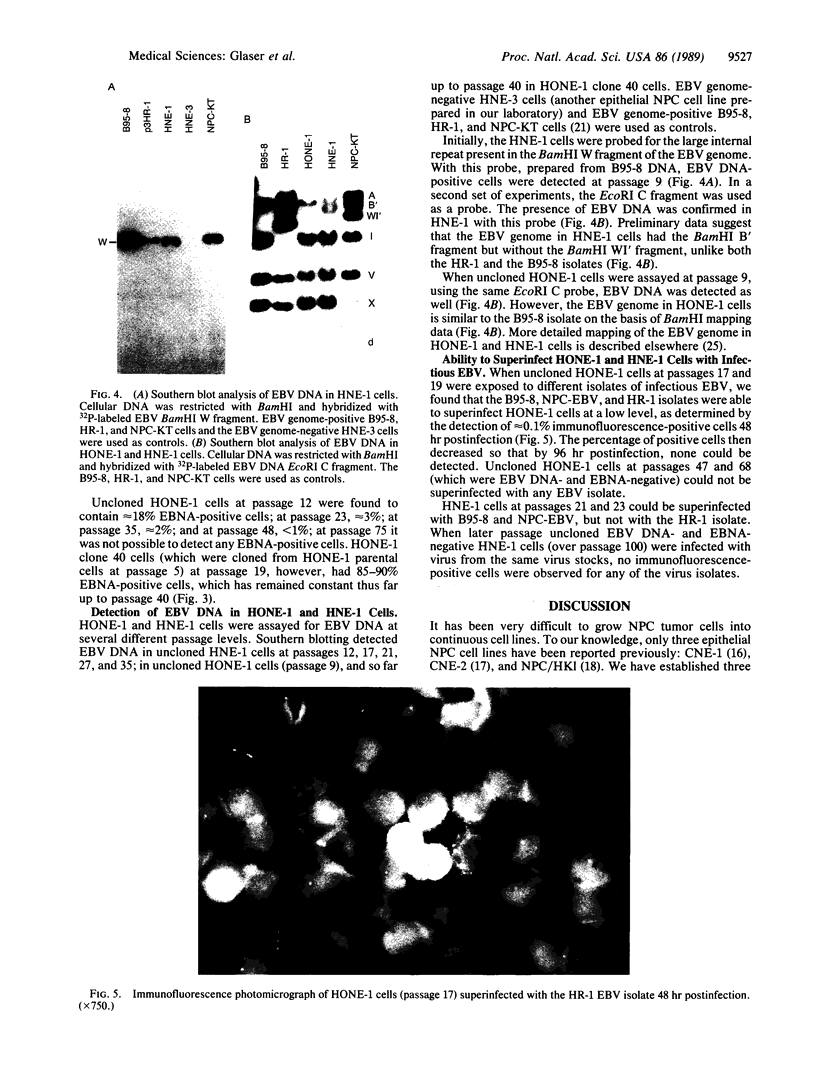
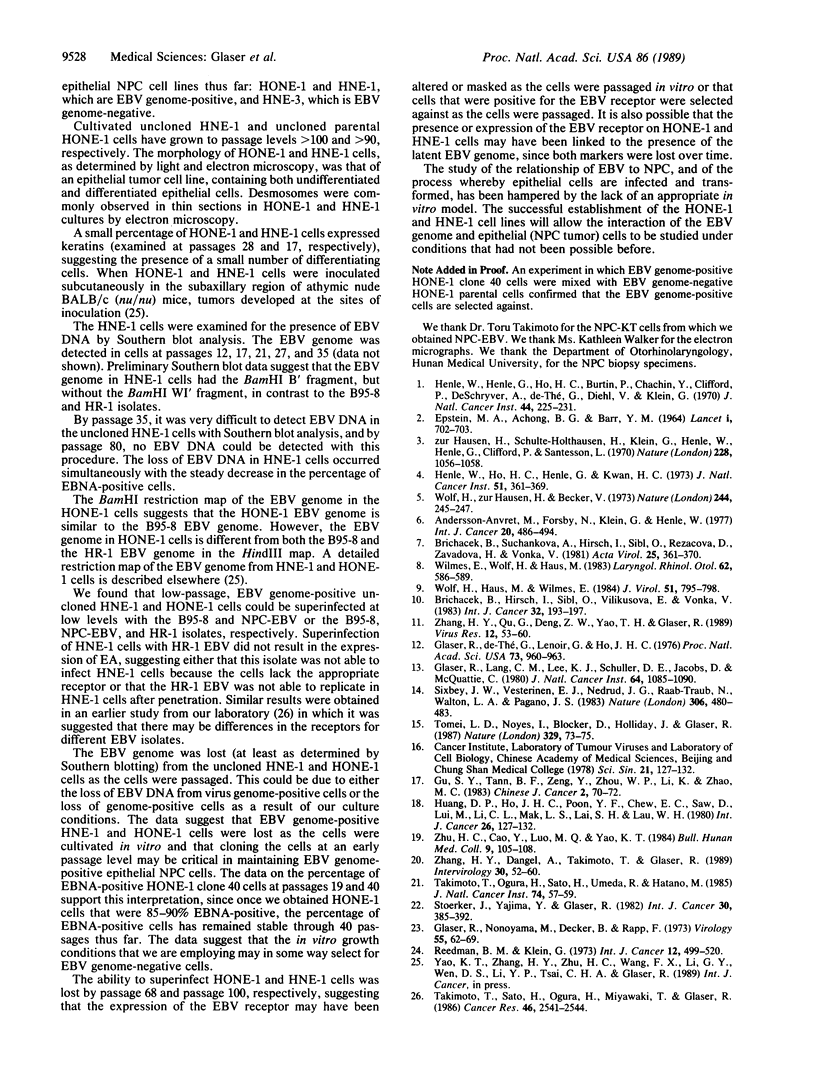
Images in this article
Selected References
These references are in PubMed. This may not be the complete list of references from this article.
- Andersson-Anvret M., Forsby N., Klein G., Henle W. Relationship between the Epstein-Barr virus and undifferentiated nasopharyngeal carcinoma: correlated nucleic acid hybridization and histopathological examination. Int J Cancer. 1977 Oct 15;20(4):486–494. doi: 10.1002/ijc.2910200403. [DOI] [PubMed] [Google Scholar]
- Brichácek B., Hirsch I., Síbl O., Vilikusová E., Vonka V. Association of some supraglottic laryngeal carcinomas with EB virus. Int J Cancer. 1983 Aug 15;32(2):193–197. doi: 10.1002/ijc.2910320209. [DOI] [PubMed] [Google Scholar]
- Brichácek B., Suchánková A., Hirsch I., Síbl O., Rezácova D., Závadová H., Vonka V. Presence of Epstein-Barr virus DNA in tonsillar tissues. Acta Virol. 1981 Nov;25(6):361–370. [PubMed] [Google Scholar]
- EPSTEIN M. A., ACHONG B. G., BARR Y. M. VIRUS PARTICLES IN CULTURED LYMPHOBLASTS FROM BURKITT'S LYMPHOMA. Lancet. 1964 Mar 28;1(7335):702–703. doi: 10.1016/s0140-6736(64)91524-7. [DOI] [PubMed] [Google Scholar]
- Glaser R., Lang C. M., Lee K. J., Schuller D. E., Jacobs D., McQuattie C. Attempt to infect nonmalignant nasopharyngeal epithelial cells from humans and squirrel monkeys with Epstein-Barr virus. J Natl Cancer Inst. 1980 May;64(5):1085–1090. [PubMed] [Google Scholar]
- Glaser R., Nonoyama M., Decker B., Rapp F. Synthesis of Epstein-Barr virus antigens and DNA in activated Burkitt somatic cell hybrids. Virology. 1973 Sep;55(1):62–69. doi: 10.1016/s0042-6822(73)81008-6. [DOI] [PubMed] [Google Scholar]
- Glaser R., de Thé G., Lenoir G., Ho J. H. Superinfection epithelial nasopharyngeal carcinoma cells with Epstein-Barr virus. Proc Natl Acad Sci U S A. 1976 Mar;73(3):960–963. doi: 10.1073/pnas.73.3.960. [DOI] [PMC free article] [PubMed] [Google Scholar]
- Henle W., Henle G., Ho H. C., Burtin P., Cachin Y., Clifford P., de Schryver A., de-Thé G., Diehl V., Klein G. Antibodies to Epstein-Barr virus in nasopharyngeal carcinoma, other head and neck neoplasms, and control groups. J Natl Cancer Inst. 1970 Jan;44(1):225–231. [PubMed] [Google Scholar]
- Henle W., Ho H. C., Henle G., Kwan H. C. Antibodies to Epstein-Barr virus-related antigens in nasopharyngeal carcinoma. Comparison of active cases with long-term survivors. J Natl Cancer Inst. 1973 Aug;51(2):361–369. [PubMed] [Google Scholar]
- Huang D. P., Ho J. H., Poon Y. F., Chew E. C., Saw D., Lui M., Li C. L., Mak L. S., Lai S. H., Lau W. H. Establishment of a cell line (NPC/HK1) from a differentiated squamous carcinoma of the nasopharynx. Int J Cancer. 1980 Aug;26(2):127–132. doi: 10.1002/ijc.2910260202. [DOI] [PubMed] [Google Scholar]
- Reedman B. M., Klein G. Cellular localization of an Epstein-Barr virus (EBV)-associated complement-fixing antigen in producer and non-producer lymphoblastoid cell lines. Int J Cancer. 1973 May;11(3):499–520. doi: 10.1002/ijc.2910110302. [DOI] [PubMed] [Google Scholar]
- Sixbey J. W., Vesterinen E. H., Nedrud J. G., Raab-Traub N., Walton L. A., Pagano J. S. Replication of Epstein-Barr virus in human epithelial cells infected in vitro. Nature. 1983 Dec 1;306(5942):480–483. doi: 10.1038/306480a0. [DOI] [PubMed] [Google Scholar]
- Stoerker J., Yajima Y., Glaser R. The interaction of non-transforming Epstein-Barr virus (EBV) with cell-associated EBV DNA in superinfected lymphoblastoid cell lines. Int J Cancer. 1982 Oct 15;30(4):385–392. doi: 10.1002/ijc.2910300402. [DOI] [PubMed] [Google Scholar]
- Takimoto T., Ogura H., Sato H., Umeda R., Hatano M. Isolation of transforming and early antigen-inducing Epstein-Barr virus from nasopharyngeal carcinoma hybrid cells (NPC-KT). J Natl Cancer Inst. 1985 Jan;74(1):57–60. [PubMed] [Google Scholar]
- Takimoto T., Sato H., Ogura H., Miyawaki T., Glaser R. Superinfection of epithelial hybrid cells (D98/HR-1, NPC-KT, and A2L/AH) with Epstein-Barr virus and the relationship to the C3d receptor. Cancer Res. 1986 May;46(5):2541–2544. [PubMed] [Google Scholar]
- Tomei L. D., Noyes I., Blocker D., Holliday J., Glaser R. Phorbol ester and Epstein-Barr virus dependent transformation of normal primary human skin epithelial cells. Nature. 1987 Sep 3;329(6134):73–75. doi: 10.1038/329073a0. [DOI] [PubMed] [Google Scholar]
- Wilmes E., Wolf H., Haus M. Tonsillenkarzinome und Epstein-Barr-Virus. Laryngol Rhinol Otol (Stuttg) 1983 Dec;62(12):586–589. [PubMed] [Google Scholar]
- Wolf H., Haus M., Wilmes E. Persistence of Epstein-Barr virus in the parotid gland. J Virol. 1984 Sep;51(3):795–798. doi: 10.1128/jvi.51.3.795-798.1984. [DOI] [PMC free article] [PubMed] [Google Scholar]
- Wolf H., zur Hausen H., Becker V. EB viral genomes in epithelial nasopharyngeal carcinoma cells. Nat New Biol. 1973 Aug 22;244(138):245–247. doi: 10.1038/newbio244245a0. [DOI] [PubMed] [Google Scholar]
- Zhang H. Y., Dangel A., Takimoto T., Glaser R. Gene mapping of an Epstein-Barr virus isolate obtained from a nasopharyngeal carcinoma. Intervirology. 1989;30(1):52–60. doi: 10.1159/000150076. [DOI] [PubMed] [Google Scholar]
- Zhang H. Y., Qu G., Deng Z. W., Yao T. H., Glaser R. Epstein-Barr virus DNA in nasopharyngeal biopsies. Virus Res. 1989 Jan;12(1):53–59. doi: 10.1016/0168-1702(89)90053-1. [DOI] [PubMed] [Google Scholar]
- zur Hausen H., Schulte-Holthausen H., Klein G., Henle W., Henle G., Clifford P., Santesson L. EBV DNA in biopsies of Burkitt tumours and anaplastic carcinomas of the nasopharynx. Nature. 1970 Dec 12;228(5276):1056–1058. doi: 10.1038/2281056a0. [DOI] [PubMed] [Google Scholar]



